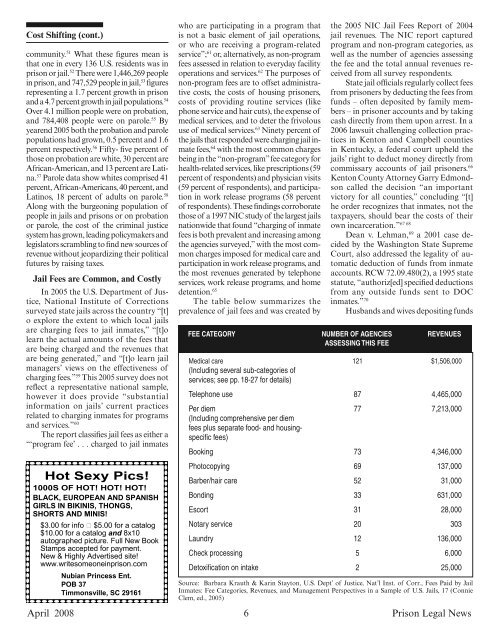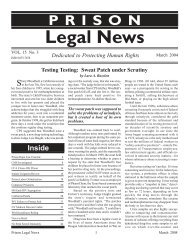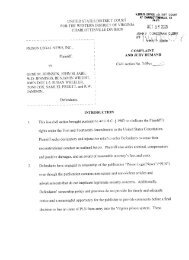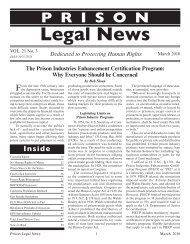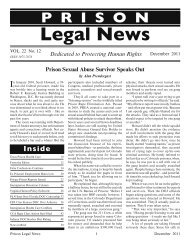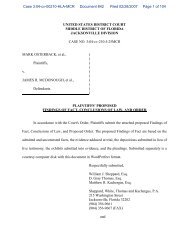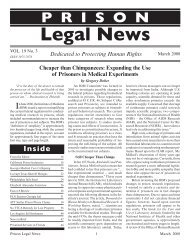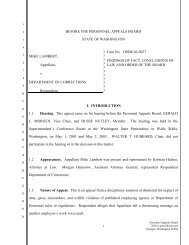From the Editor - Prison Legal News
From the Editor - Prison Legal News
From the Editor - Prison Legal News
You also want an ePaper? Increase the reach of your titles
YUMPU automatically turns print PDFs into web optimized ePapers that Google loves.
Cost Shifting (cont.)<br />
community. 51 What <strong>the</strong>se figures mean is<br />
that one in every 136 U.S. residents was in<br />
prison or jail. 52 There were 1,446,269 people<br />
in prison, and 747,529 people in jail, 53 figures<br />
representing a 1.7 percent growth in prison<br />
and a 4.7 percent growth in jail populations. 54<br />
Over 4.1 million people were on probation,<br />
and 784,408 people were on parole. 55 By<br />
yearend 2005 both <strong>the</strong> probation and parole<br />
populations had grown, 0.5 percent and 1.6<br />
percent respectively. 56 Fifty- five percent of<br />
those on probation are white, 30 percent are<br />
African-American, and 13 percent are Latina.<br />
57 Parole data show whites comprised 41<br />
percent, African-Americans, 40 percent, and<br />
Latinos, 18 percent of adults on parole. 58<br />
Along with <strong>the</strong> burgeoning population of<br />
people in jails and prisons or on probation<br />
or parole, <strong>the</strong> cost of <strong>the</strong> criminal justice<br />
system has grown, leading policymakers and<br />
legislators scrambling to find new sources of<br />
revenue without jeopardizing <strong>the</strong>ir political<br />
futures by raising taxes.<br />
Jail Fees are Common, and Costly<br />
In 2005 <strong>the</strong> U.S. Department of Justice,<br />
National Institute of Corrections<br />
surveyed state jails across <strong>the</strong> country “[t]<br />
o explore <strong>the</strong> extent to which local jails<br />
are charging fees to jail inmates,” “[t]o<br />
learn <strong>the</strong> actual amounts of <strong>the</strong> fees that<br />
are being charged and <strong>the</strong> revenues that<br />
are being generated,” and “[t]o learn jail<br />
managers’ views on <strong>the</strong> effectiveness of<br />
charging fees.” 59 This 2005 survey does not<br />
reflect a representative national sample,<br />
however it does provide “substantial<br />
information on jails’ current practices<br />
related to charging inmates for programs<br />
and services.” 60<br />
The report classifies jail fees as ei<strong>the</strong>r a<br />
“‘program fee’ . . . charged to jail inmates<br />
Hot Sexy Pics!<br />
1000S OF HOT! HOT! HOT!<br />
BLACK, EUROPEAN AND SPANISH<br />
GIRLS IN BIKINIS, THONGS,<br />
SHORTS AND MINIS!<br />
$3.00 for info $5.00 for a catalog<br />
$10.00 for a catalog and 8x10<br />
autographed picture. Full New Book<br />
Stamps accepted for payment.<br />
New & Highly Advertised site!<br />
www.writesomeoneinprison.com<br />
Nubian Princess Ent.<br />
POB 37<br />
Timmonsville, SC 29161<br />
April 2008<br />
who are participating in a program that<br />
is not a basic element of jail operations,<br />
or who are receiving a program-related<br />
service”; 61 or, alternatively, as non-program<br />
fees assessed in relation to everyday facility<br />
operations and services. 62 The purposes of<br />
non-program fees are to offset administrative<br />
costs, <strong>the</strong> costs of housing prisoners,<br />
costs of providing routine services (like<br />
phone service and hair cuts), <strong>the</strong> expense of<br />
medical services, and to deter <strong>the</strong> frivolous<br />
use of medical services. 63 Ninety percent of<br />
<strong>the</strong> jails that responded were charging jail inmate<br />
fees, 64 with <strong>the</strong> most common charges<br />
being in <strong>the</strong> “non-program” fee category for<br />
health-related services, like prescriptions (59<br />
percent of respondents) and physician visits<br />
(59 percent of respondents), and participation<br />
in work release programs (58 percent<br />
of respondents). These findings corroborate<br />
those of a 1997 NIC study of <strong>the</strong> largest jails<br />
nationwide that found “charging of inmate<br />
fees is both prevalent and increasing among<br />
<strong>the</strong> agencies surveyed,” with <strong>the</strong> most common<br />
charges imposed for medical care and<br />
participation in work release programs, and<br />
<strong>the</strong> most revenues generated by telephone<br />
services, work release programs, and home<br />
detention. 65<br />
The table below summarizes <strong>the</strong><br />
prevalence of jail fees and was created by<br />
6<br />
<strong>the</strong> 2005 NIC Jail Fees Report of 2004<br />
jail revenues. The NIC report captured<br />
program and non-program categories, as<br />
well as <strong>the</strong> number of agencies assessing<br />
<strong>the</strong> fee and <strong>the</strong> total annual revenues received<br />
from all survey respondents.<br />
State jail officials regularly collect fees<br />
from prisoners by deducting <strong>the</strong> fees from<br />
funds – often deposited by family members<br />
– in prisoner accounts and by taking<br />
cash directly from <strong>the</strong>m upon arrest. In a<br />
2006 lawsuit challenging collection practices<br />
in Kenton and Campbell counties<br />
in Kentucky, a federal court upheld <strong>the</strong><br />
jails’ right to deduct money directly from<br />
commissary accounts of jail prisoners. 66<br />
Kenton County Attorney Garry Edmondson<br />
called <strong>the</strong> decision “an important<br />
victory for all counties,” concluding “[t]<br />
he order recognizes that inmates, not <strong>the</strong><br />
taxpayers, should bear <strong>the</strong> costs of <strong>the</strong>ir<br />
67 68<br />
own incarceration.”<br />
Dean v. Lehman, 69 a 2001 case decided<br />
by <strong>the</strong> Washington State Supreme<br />
Court, also addressed <strong>the</strong> legality of automatic<br />
deduction of funds from inmate<br />
accounts. RCW 72.09.480(2), a 1995 state<br />
statute, “authoriz[ed] specified deductions<br />
from any outside funds sent to DOC<br />
inmates.” 70<br />
Husbands and wives depositing funds<br />
Fee category Number of Agencies revenues<br />
A<br />
assessing this fee<br />
Medical care 121 $1,506,000<br />
(Including several sub-categories of<br />
services; see pp. 18-27 for details)<br />
Telephone use 87 4,465,000<br />
Per diem 77 7,213,000<br />
(Including comprehensive per diem<br />
fees plus separate food- and housingspecific<br />
fees)<br />
Booking 73 4,346,000<br />
Photocopying 69 137,000<br />
Barber/hair care 52 31,000<br />
Bonding 33 631,000<br />
Escort 31 28,000<br />
Notary service 20 303<br />
Laundry 12 136,000<br />
Check processing 5 6,000<br />
Detoxification on intake 2 25,000<br />
Source: Barbara Krauth & Karin Stayton, U.S. Dept’ of Justice, Nat’l Inst. of Corr., Fees Paid by Jail<br />
Inmates: Fee Categories, Revenues, and Management Perspectives in a Sample of U.S. Jails, 17 (Connie<br />
Clem, ed., 2005)<br />
<strong>Prison</strong> <strong>Legal</strong> <strong>News</strong>


